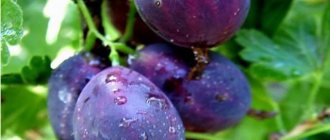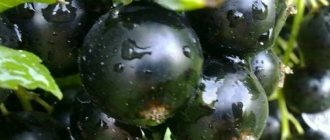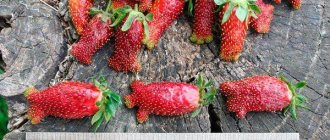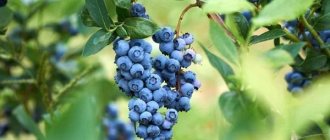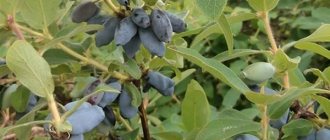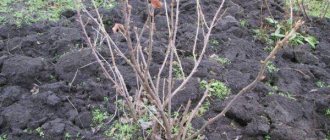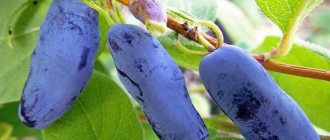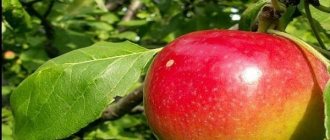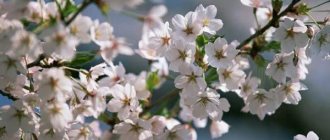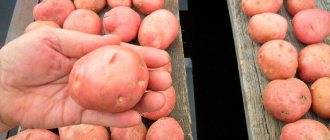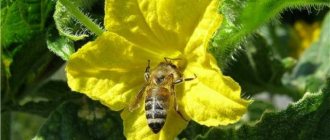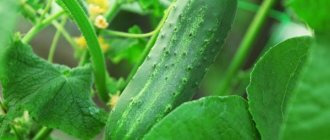Description of gooseberry Northern Captain
Gooseberry Captain grows as a tall, dense bush. Under the weight of the harvest, the young green shoots bend archly. Adult branches become lignified and acquire a gray color. Stems are strongly branched without pubescence.
Short thorns (up to 7 mm) rarely grow on adult branches, and are completely absent on young shoots. The spines are thin, straight, single, most often formed at the base of the branches. The overall degree of studding is assessed as weak.
The leaves of the Captain gooseberry are large, glossy, and three-lobed. Just like on the buds and stems, there is no pubescence on them. The leaf blades are rich green in color and slightly wrinkled.
Greenish large flowers, collected 2 or 3 in a raceme. Each petal is marked with a reddish stroke along the edge.
Characteristics of Northern Captain gooseberries:
- the size of the fruits on the bush is even, the weight is within 3.5–4 g;
- color – from dark red to deep burgundy and black;
- the veins stand out in a light shade;
- the peel is thick, covered with a waxy coating;
- the seeds are small.
Sugars in ripe fruits accumulate up to 9%, but the significant content of vitamin C gives the berries a sour taste. The unpretentious crop can be grown both in the north-western part of Russia and in warmer regions.
Reproduction
The northern captain reproduces by all vegetative methods, but the following three are the most effective:
- dividing the bush;
- using cuttings cut in early summer;
- propagation by layering.
The easiest way is propagation by layering. In the spring, a small groove is made under the bush into which the shoot is placed. It is sprinkled with earth, leaving only the top on the surface. The soil around the stem is kept moist. Over the summer, roots will appear on the branch, after which the cuttings can be transplanted to a permanent place.
Dividing the bush is suitable when transplanting an adult plant to another area. The planting rules for this method of propagation do not differ from planting a young seedling.
When propagating by cuttings at the beginning of summer, it is necessary to cut a shoot up to 15 cm long from the bush, which is planted in the ground or container with fertile soil. Throughout the season, it is cared for as usual, regularly watering and loosening the soil, and after roots appear, in early autumn, it is transplanted into a prepared hole.
HOW TO PROPAGATE GOOSEBERRY? PROPAGATION OF GOOSEBERRY IN SPRING
Characteristics of the variety
The self-fertile variety Captain can be cultivated in single plantings. The presence of other types of gooseberries in the garden increases its yield slightly. Cross-pollination with other varieties is not necessary for Captain.
The crop is distinguished by its increased ability to restore dead shoots, the roots are frost-resistant, the yield is stable, and with appropriate care it is consistently high.
Drought resistance, frost resistance
As a rule, Northern Captain bushes easily tolerate the cold season with extreme temperatures down to -30 °C. Winters in the north-west of Russia are frosty, windy, and in recent years the snow cover has been unstable. Therefore, gooseberries need hilling and mulching. Additional cover of the above-ground part is not required.
The crop tolerates slight drying out of the soil. But gooseberry roots lie shallow, so prolonged drought can lead to the death of part of the bush. During periods when natural precipitation is insufficient, Northern Captain requires moisture once a week. The roots should not be allowed to dry out during fruit laying or filling. Without watering at this time, the berries become smaller.
Productivity and fruiting
The gooseberry variety Northern Captain in the regions where it is zoned shows the best varietal qualities. The berries begin to ripen at the end of July. The variety belongs to the mid-late variety. Ripe berries are easily removed when harvesting, but do not tend to fall off on their own.
The Captain gooseberry bush is capable of not losing yield for up to 20 years. Proper care and pruning significantly prolongs active fruiting. According to gardeners, an adult Northern Captain gooseberry bush produces an average of about 3 kg of berries per season. There is evidence of yields of up to 4 kg per adult plant.
Comment! Even if the bush is left without care, the viable variety Captain is capable of stably forming ovaries and producing up to 2 kg of fruit.
Area of application of fruits
In food production, Captain gooseberries are used in the production of wines, juices with pulp, and a natural dye is extracted from it. At home, the berries are processed into jams, jellies, marmalades, compotes, and tinctures. Gooseberry desserts are preserved for the winter.
Thick skin and a high content of natural preservatives provide Northern Captain berries with a long shelf life and excellent transportability.
Gooseberry Northern Captain, according to the description of the variety, belongs to industrial crops. It is not considered a dessert, although reviews from amateur gardeners indicate its popularity as an independent delicacy.
Resistance to diseases and pests
The Captain variety has increased resistance to most diseases. Plants do not suffer from powdery mildew; cases of septoria and anthracnose are rare. Dangerous gooseberry pests (sawfly, moth) avoid the bushes of the Northern Captain.
Advantages and disadvantages of the variety
The main advantage of Northern Captain over other varieties is its vitality and durability in adverse conditions. Other advantages include:
- frost resistance;
- immunity to infections, pests;
- high nutritional value of berries, their keeping quality;
- ability to reproduce by all vegetative means.
Among the disadvantages is the high acid content in the fruits. Gardeners also note the tendency of the variety to form many shoots. Young stems greatly thicken the middle of the bush in one season.
Advantages and disadvantages of the variety
Gardeners prefer the variety primarily because of its winter hardiness and productivity. In addition, the Northern Captain is highly resistant to pests and diseases, and almost never suffers from powdery mildew and anthracnose. The gooseberry sawfly and moth do not harm this variety.
Advantages of the variety
- small number of thorns;
- easily takes root with any type of propagation;
- suitable for standard cultivation;
- The berries are well stored and transportable.
- high resistance to septoria
Disadvantages of the variety
- the bush is spreading, dense, requires garter;
- small-fruited;
- not the highest taste qualities.
Rules for planting gooseberries
Having only one gooseberry bush, the Northern Captain variety, it can be easily propagated by any of the vegetative methods. Layers and cuttings take root well. Bush division and grafting are applicable. To obtain all varietal characteristics and stable yields for decades to come, the greenery of the plant should be planted correctly.
Recommended timing
Young plants are planted in the fall, calculating the timing so that there is at least a month left before persistent cold weather. Gooseberry roots adapt to frost and begin the growing season earlier. In spring, it is difficult to choose the right time so that the young shoots of the Northern Captain do not fall under recurrent frosts.
Choosing a suitable location
For varietal gooseberries, choose sunny areas in the garden. From the north, plantings will be well protected from cold winds by tall buildings, fences, and dense plantings.
The Northern Captain gooseberry is unpretentious to the soil. It should not be too heavy, exhausted and sour. It is not desirable for gooseberries to have close groundwater or stagnation of moisture when snow melts.
Selection and preparation of planting material
A healthy varietal seedling of Captain meets the following criteria:
- age – 2 years;
- woody roots;
- shoots are healthy and flexible.
If the roots dry out during transportation, you should soak the gooseberry seedlings overnight in water. Increases survival rate by adding growth stimulants to the solution.
Landing algorithm
Preparing the site for the Northern Captain begins with weeding, digging, and adding the necessary substances to the soil. Acidic soils are limed or dolomite flour is added for treatment. On heavy soils, permeability is increased by adding sand, peat, and compost.
Sequence of planting gooseberries Northern Captain:
- Prepare a pit 50x50 cm.
- Half is covered with fertile soil mixture.
- Lower the seedling onto the planting site and straighten the roots, gradually adding soil.
- The soil is lightly compressed, tamping as the hole is filled.
- Water the seedling abundantly and wait until the soil settles completely.
- Check the height of the root collar: for the Captain gooseberry, it should be sunk 6–8 cm into the soil. If necessary, correct the planting depth.
Advice! The fertile mixture for gooseberries includes compost, humus, potassium and phosphorus fertilizers. Mix well a little sand and 250 g of wood ash per bush into the soil.
After planting is completed, the soil around the gooseberries is mulched and the first pruning is performed. All shoots are shortened to 5–6 living buds.
How to grow a crop
To grow a healthy plant with high yields, you should not only follow the planting rules, but also choose high-quality planting material and properly prepare the soil. The same recommendations apply to Finnish varieties as for other varieties.
Disembarkation time
Finnish gooseberries can be planted in both spring and autumn. Autumn (until mid-October) is the more preferable time for planting. Before the onset of frost, gooseberries form young roots, which contributes to better survival.
Due to the early growing season, the time for spring planting is limited to March - early April. When planted at a later date, the plants develop worse and begin to bear fruit later.
Soil preparation
The choice of planting site and soil preparation is one of the determining factors in the yield of Finnish gooseberry varieties. There are rules common to these varieties:
- The planting area should be level, well lit, and moderately moist. A slope of 1-3 degrees is allowed. The occurrence of groundwater is no closer than 1 m from the surface.
- Row crops (corn, beets, potatoes), annual and perennial grasses, and black fallow are considered good predecessors.
- The variety is suitable for fertile, loose loamy soils. You should start preparing the soil 1-2 years before planting. To do this, they fight weeds, apply organic fertilizers, and lime acidic soils.
- In the year of planting in September, the soil is dug up with the addition of organic fertilizers (compost or manure), superphosphate, and potassium salt. You can sow green manure on the site.
Planting in shaded areas with high groundwater levels or in wetlands leads to poor development of gooseberries and causes disease.
Selection of planting material
For planting, use healthy seedlings that meet the following requirements:
- the ground part should consist of three strong shoots with a basal stem diameter of about 1 cm;
- The root system must be developed, the length of the roots is 20-30 cm.
Planting process
The planting process is normal for gooseberries. Planting should be done in the following sequence:
- Prepare furrows (width 40 cm, depth 25-30 cm) or holes (width 40 cm, length 30-50 cm, depth up to 40 cm). Form rows at a distance of 3-3.5 m from each other.
- Straighten the roots of the seedling. Place the plant in the hole, sprinkle with fertile soil. Compact the soil around the seedlings and water well (half a bucket of water per bush). Mulch the surface with dry soil, peat mixture or humus.
It is recommended to cut the stems to 5 cm, keeping 3-4 buds per shoot. It is believed that this speeds up the formation of the bush.
Follow-up care for gooseberries
Gooseberry Northern captain loves moisture, but can respond to swampiness with soreness. The variety does not require constant watering - in zoned areas, natural precipitation may be sufficient for it.
In spring, gooseberries wake up early and manage to use melt water for accelerated growth. At this time, the variety can be helped by applying nitrogen fertilizers.
Before flowering, it is permissible to water the Northern Captain bushes with a solution of chicken droppings or well-rotted manure. Further nitrogenous feeding of gooseberries is excluded. Twice a season, potassium and phosphorus mineral compositions are applied to each bush.
In a rainy summer, caring for the Northern Captain can be reduced to periodic loosening and weeding. Fertilizers can be scattered in granules around the bush; they will gradually be soaked by rain and penetrate into the soil.
Pruning is a mandatory procedure for caring for the Northern Captain variety. Shoots grow not only on the outside, but also inside. A thickened bush can get fungal infection, despite varietal resistance. Overgrowth of the crown is especially dangerous during the rainy season.
The principles of pruning young gooseberries Northern Captain are shown in the photo, where:
- pruning after planting;
- formation at the end of the first season.
Features of the formation of an adult fruit-bearing bush of the Northern Captain:
- In autumn, all young shoots are cut down to the ground, leaving 4–5 of the strongest stems. The tops of annual shoots are removed.
- Damaged and old branches are cut off and the remaining ones are shortened.
- An adult gooseberry bush should consist of 20–25 strong stems of different ages. All branches older than 6 years are removed into a ring near the soil surface.
By following these principles, you can maintain the fruiting of the Northern Captain bush for more than 20 years.
Growing technology
Agricultural technology for this variety is standard. In zoning areas, it does not require frequent watering, special preparation for winter and worries about diseases.
Optimal conditions
To plant the Northern Captain, select an area with good lighting and protection from drafts. It is important that when the snow melts, melt water does not accumulate on the beds. The soil should be nutritious and loose, with neutral acidity.
Landing dates and rules
It is best to plant young plants in the fall, adjusting to weather conditions so that the seedling has time to take root before persistent cold weather begins. It is better not to plant in spring - the sprouts may suffer from return frosts.
The seedling must be two years old, with woody roots and flexible, healthy shoots. Planting is done as follows:
- The root system of the seedling is soaked for 2-3 hours in a stimulator (for example, “Kornevin”).
- A hole of 50x50 cm is prepared for each bush. 1.5 m is maintained between bushes, 2-2.5 m between rows.
- Some of the soil is mixed with humus and returned to the hole, being careful not to compact it too much.
- The seedling is placed in a planting place, gradually covered with earth and compacting it.
- The root collar should be immersed 6-8 cm in the soil, otherwise the seedling will die.
- The bush is watered with 10 liters of water, after which the shoots are cut off, leaving 5-6 buds on each.
In addition to humus, a mixture of compost, potash and phosphate fertilizers is used when planting. Experienced gardeners recommend adding a little sand and wood ash to the soil (250 g for each bush).
How to plant gooseberries correctly Features of planting gooseberries in autumn and care
Further care
In order for a seedling to grow well and produce a stable harvest, it requires proper care. It includes the following agricultural practices:
- Watering. In the north-west of Russia, in areas where the variety is zoned, Northern Captain does not experience a lack of moisture, receiving it from natural precipitation. In spring, the plant wakes up early and uses melt water to grow. In rainy summers, gooseberries are not watered, but if there is not enough rainfall, 10-15 liters of water are poured under each bush once a week, preventing the roots from drying out.
- Feeding. For the first two years after planting, the gooseberry needs only the fertilizers that have already been added to the soil. In the future, the bushes must be fed in the spring, using a mixture of 10 kg of rotted manure, 80 g of superphosphate, 40 g of nitrate and 20 g of potassium chloride.
- Loosening. In a rainy summer, caring for the Northern Captain can only come down to weeding and garbage collection. Remember that gooseberry roots are shallow, so only loosen the top layer of soil. They do this after every rain or watering, simultaneously removing stones, branches and other debris.
- Trimming. Since young shoots thicken the crown every season, gooseberries need to be pruned regularly. From the second to the fourth year, formative pruning is done, shortening the adult branches by half. Crooked, dry or weak branches are removed completely. From the fifth year, crown thickening is eliminated, leaving 20-25 shoots aged from 3 to 6 years. Older branches practically do not bear fruit and only draw strength from the bush. Pruning is done in the fall, after the leaves have fallen.
Possible problems, diseases, pests
Northern captain is a resistant berry crop, so it is not afraid of diseases and pest invasions. It is enough to carry out preventive measures in a timely manner and there will be no problems with growing this gooseberry.
Important . After pruning the bushes, fallen leaves and eliminated shoots are burned outside the site. This will prevent pests and bacteria from successfully overwintering and causing damage to the planting next season.
Preventative measures include the following:
- In the spring, before the buds swell, the branches of the Northern Captain are watered with hot water from a watering can.
- Twice a season, before flowering and after harvesting, each bush and the ground under them are treated with Fitosporin-M solution, according to the instructions on the package.
- Remove branches, leaves and other debris in a timely manner.
- You can plant mint, tomatoes or wormwood next to the gooseberries. These plants repel insects.
- At the first signs of the disease, the affected branches are pruned and burned, and the bushes are treated with Bordeaux mixture (100 g per 10 l of water) or a solution of wood ash (200 g per 10 l).
IT'S TIME TO SAVE GOOSEBERRY from powdery mildew! 5 safe recipes for processing berries
Wintering
The variety is frost-resistant, so it does not need additional shelter. It is enough to hill it up and then mulch it with rotted manure.
Diseases and pests, methods of control and prevention
Gooseberry Captain, according to the description of the variety, belongs to the resistant berry crops. It is not damaged by major infectious diseases.
Pests typical of gooseberries also do not threaten the bushes of the Northern Captain variety. To protect plantings, preventive measures are sufficient. Pollinating the soil under the bushes with wood ash simultaneously repels insects and feeds the gooseberries with potassium.
Important! All remnants of leaves and cuttings of branches in the fall should be removed from under the gooseberry bushes and burned outside the garden. This will prevent larvae or adult insects from overwintering and causing damage next year.
Main pros and cons
During breeding, Finnish varieties have achieved resistance to many diseases characteristic of gooseberries. They are highly resistant to powdery mildew, including spheroteca and mildew. Resistance to other fungal diseases is average.
Frost-resistant varieties. Withstands temperatures down to -30 degrees. They bear fruit consistently, do not fall off if properly cared for, and take root well. The berries are sweet and versatile in use.
Main disadvantages:
- prickliness;
- average size and weight of berries.
It is generally accepted that thorny varieties, which include Finnish gooseberries, have sweeter berries than thornless varieties.
The best varieties for growing in the Moscow region
The climatic features of the Moscow region dictate special requirements for gooseberry varieties. The plant must withstand both prolonged frosty periods and sudden thaws, adapt to a small number of sunny days and prolonged rainy periods. Currently, more than a thousand gooseberry varieties have been bred, which theoretically can be grown in such conditions. Let's figure out together which of them will give the best results.
The largest-fruited
Large fruits are quick and easy to collect, and they look aesthetically attractive. Many gardeners grow large-fruited varieties:
- Defender. The berries of this variety reach 10 grams. The bushes are tall and the branches are strong. The berries are oval, pear-shaped, dark burgundy, almost black.
- Cooperator. Pear-shaped berries, at least 7-8 grams. The bush looks very impressive; when ripe, the berries acquire a bright red hue.
- Leningrader. Fruits weigh 10 grams, dark red. Those who like sweet and sour varieties will like it.
- Spring. The fruits are yellow-green in color, weighing up to 8 grams. Good fresh and in “twists” for the winter. Able to bear fruit during prolonged cold and drought.
- Kolobok. The berries are round in shape, with a sweet and sour taste, and are distinguished by a high content of ascorbic acid. It bears fruit for a long time, the berries are transportable and perfectly stored. They get about 10 kg from the bush. berries
The sweetest
Gooseberries are valued for their taste. There are many sweet varieties, the fruits of which seem to melt in your mouth and leave a pleasant aftertaste:
- Belarusian sugar. The bush is small, with thorns, the inconvenience of which is compensated by the delicate, sweet pulp and thin skin. Differs in frost resistance.
- Amber. Sweet, delicate taste. There is an unobtrusive sourness, but it emphasizes the sweetness and does not interfere with enjoying the delicious fruit with a honey aroma. Color - yellow-orange.
- Russian yellow. Resistant to cracking, delights with its taste both fresh and preserved. Pulp with pleasant sweetness and aroma.
- Candy. Increased resistance to drought and cold. The fruits are sweet, pleasant, aromatic. It’s not for nothing that the variety has such a name – candy.
- White Nights. The berries are quite small, about 3 g, but very sweet, which is an undeniable advantage of the variety. Ripens early, resistant to powdery mildew.
Thornless varieties
- Grushenka. It is distinguished by its unpretentiousness to weather conditions, sweet taste combined with the fleshiness of the berries. Doesn't require much attention. Resistant to frost.
- Sirius. Good for long-term storage, retains its unique original taste and aroma for a long time. It tolerates freezing well due to its thick skin. The berries are small, bright red. Pulp with pleasant sourness.
- Northern captain. Violet-red berries hold well on beautiful spreading bushes. Green leaves may have a red edge. Refreshing sweet taste with sourness.
- Eaglet. Aronia gooseberry has a unique color that retains its ruby color in processed products. Belongs to early ripening varieties. The berries are oval-shaped, with a waxy coating.
- Commander. The berries are burgundy-brown (raspberry inside) similar to large black currants. Sugary, sour, with a very pleasant aroma. It is distinguished by high yield with good care.
- Ural thornless. Sweet tender berries, there is a hint of sourness. The bush is tall, the fruiting shoots are large. The plant is resistant to powdery mildew and many other gooseberry diseases.
- African. A high-yielding variety, it’s easy to pick a bucket of sweet and sour fruits with a “currant” taste from the bush. Tolerates spring frosts well. The fruits are black and large.
general information
By crossing the Pink variety with a form that has no name and is designated by numbers, Russian breeders developed gooseberries that received various positive characteristics. There is no pubescence on the green shoots of the shrub, which have large leaves. With age, the branches become lignified, acquire a grayish tint, and are covered with short thorns. The light green flowers, which are collected in clusters, have red stripes.
Based on the description of the Northern Captain gooseberry, the ovary on the plant is formed without the proximity of pollinators. The presence of such varieties does not greatly affect the yield. Towards the end of July, dark red berries with light veins ripen. The dense skin of the fruit, whose weight does not exceed 4 grams, is covered with a purine coating.
Gooseberries do not crumble even after ripening, they have a unique taste; they are sweetened by sugar and acidic by vitamin C. The dark-colored berries are rich in:
- carotene and rutin;
- pectins and serotonin;
- iron and phosphorus;
- zinc and magnesium.
Juice is squeezed out of the fruits of the Northern Captain, which cleanses the body of salts and metals and improves the condition of the digestive tract. The berries are used to make jams, marmalade, and homemade wine. Gardeners who grow this variety claim that gooseberries practically do not suffer from powdery mildew and are not affected by anthracnose or white spot.
From 2 to 3 kg of berries are collected from the bush. Proper care can extend the fruiting of the plant up to 20 years.
Harvesting and transportation
Gooseberries, as a rule, ripen at the same time. Therefore, the harvest will not last for a long time. As soon as the berries reach the stated size, the skin turns dark red, and sweetness appears in the pulp, they can be removed from the bushes. For processing, the fruits are harvested in a state of technical ripeness - still slightly sour.
Berry picking is carried out manually, mechanized and semi-mechanized. When cleaning with your hands, protect your hands with gloves and long sleeves. The branches need to be carefully lifted with one hand, and the berries carefully picked with the other, leaving the stalk behind. For mechanical collection, a special vibrator is used. This method allows you to collect berries in a short time, but has one significant drawback - it removes both ripe and unripe fruits, indiscriminately. Therefore, in the future the crop needs to be sorted.
For semi-mechanized collection, a special device called a comb is used. It can be purchased or made with your own hands. The comb is placed on the thumb, passed along the branch and several berries without a stalk are picked at the same time.
Fully ripe berries can be stored in the refrigerator for 4 days. Unripe - up to 10 days. Selected and discarded berries with dry skin can be stored at 0°C for up to 1.5 months. To preserve healthy fruits for up to six months, they can be frozen. Berries must be transported in containers with a volume of up to 2.5 liters. After harvesting, it is recommended to refrigerate fruits intended for transportation.
Did you know? Kiwi is a cultivated version of the Chinese gooseberry.
